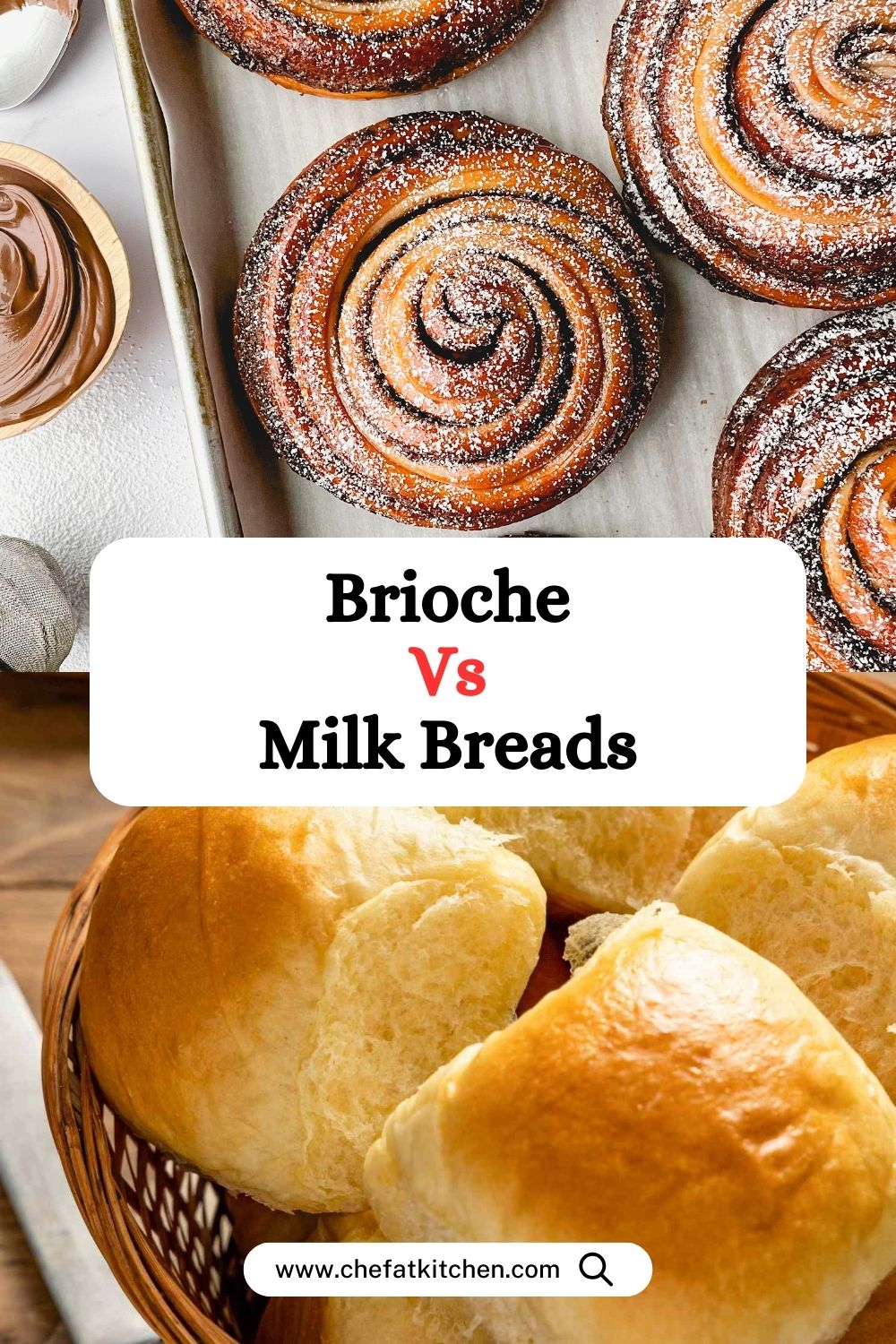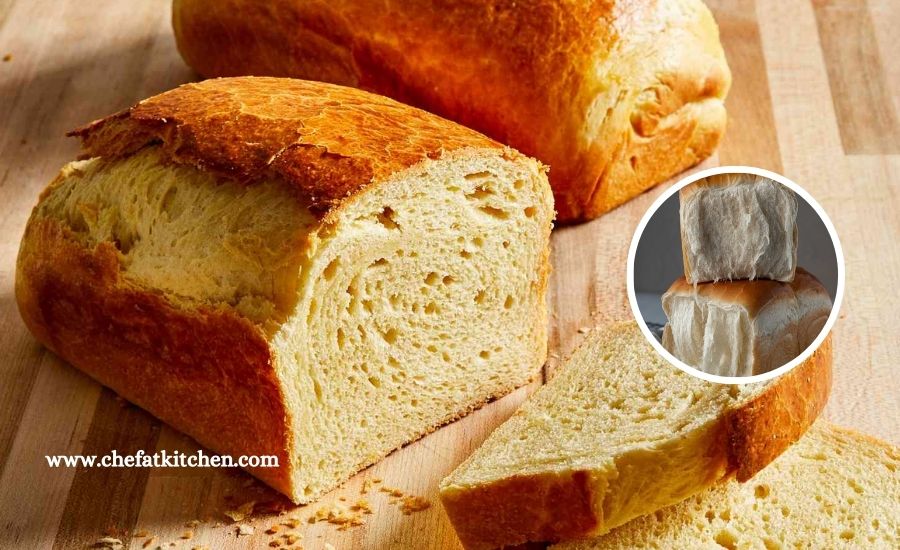Every product is independently reviewed and selected by our editors. If you buy something through our links, we may earn an affiliate commission at no extra cost to you.
Brioche and milk bread are both rich, soft, and slightly sweet bread varieties, but they differ in their ingredients and preparation methods.
Brioche is made with a higher proportion of butter and eggs, giving it a rich and tender crumb, while milk bread uses milk and sugar to create a soft and fluffy texture with a subtle sweetness.
Whether you’re a home baker or a professional chef, knowing the differences between brioche and milk bread can elevate your culinary creations and expand your baking repertoire.
In this article, we’ll explore the key differences between Brioche and Milk Bread, helping you understand which might be the perfect choice for your next culinary adventure.
Brioche Vs Milk Bread – Quick Overview

Brioche and Milk Bread (often referred to as Japanese Milk Bread or Shokupan) are both incredibly soft, fluffy breads, beloved for their rich flavors and tender textures.
While they share some similarities in texture and appearance, they originate from different culinary traditions (French for Brioche and Japanese for Milk Bread) and have distinct characteristics in terms of ingredients, preparation, and taste.
Here’s a comparison:
| Feature | Brioche | Milk Bread |
|---|---|---|
| Origin | French | Various, including Asian and Japanese |
| Texture | Flaky and buttery | Soft and pillowy |
| Key Ingredients | High butter and eggs | Milk, with lower fat content |
| Flavor | Rich and indulgent | Mild and neutral |
| Versatility | Ideal for sweet pastries and desserts | Suitable for both sweet and savory dishes |
| Applications | French toast, bread pudding, pastries | Sandwiches, dinner rolls, versatile in various recipes |
| Fat Content | Higher | Lower |
| Culinary Traditions | French | Various, including Asian and Japanese |
| Popular Uses | Breakfast pastries, desserts | Sandwiches, dinner rolls, everyday bread |
| Adaptability | Best suited for sweet applications | Well-suited for both sweet and savory dishes |
| Taste Preference | Those who enjoy a rich, buttery taste | Those who prefer a milder, more neutral flavor |
| Overall Appeal | Decadent and luxurious | Soft, versatile, and adaptable |
In summary, while both brioche and milk bread offer soft, rich textures, brioche leans towards a richer, buttery flavor, making it ideal for luxurious treats and hearty sandwiches.
Milk Bread, with its lighter, fluffier texture and slightly sweet taste, is perfect for a wide range of uses from simple breakfasts to delicate sandwiches.
What Is Brioche Bread?
In the world of bread, brioche holds a special place. With its rich, buttery flavor and indulgent aroma, this French classic is a favorite among bread enthusiasts.
Brioche bread is not your typical loaf – it’s soft, light and slightly sweet, making it perfect for a variety of uses.
Let’s dive into the details of brioche bread, starting with its ingredients and preparation.
Ingredients And Preparation
The key to a perfect brioche lies in its ingredients. Traditional brioche recipes call for flour, eggs, butter, sugar, and yeast.
The combination of these high-quality ingredients results in a dough that is both tender and flavorful.
To prepare this decadent bread, the dough goes through a process of kneading and rising, allowing the flavors to develop and the texture to become light and airy.
| Ingredient | Function |
|---|---|
| Flour | Provides structure and texture |
| Eggs | Adds richness and tenderness |
| Butter | Gives the bread a rich, buttery flavor |
| Sugar | Enhances sweetness and aids in browning |
| Yeast | Leavens the dough and contributes to its lightness |
Once the dough is prepared, it is shaped into various forms, such as loaves, buns or even intricate braids.
Brioche bread is often brushed with an egg wash before baking to give it a glossy, golden finish.
Flavor And Texture
The flavor and texture of brioche bread sets it apart from other types of bread. Its rich, buttery taste adds a luxurious element to any dish.
From sandwiches and French toast to burger buns and bread pudding, brioche bread elevates any culinary creation.
When it comes to texture, brioche is exceptionally tender and delicate. Its airy crumb and soft crust make it a joy to sink your teeth into.
The subtle sweetness of the bread adds another layer of enjoyment, making it not just a simple carbohydrate but a delightful treat.
Whether enjoyed on its own or used as a base for other recipes, brioche bread is a versatile and delicious choice.
Its distinctive flavor and texture make it a staple in French cuisine and a favorite indulgence around the world.
What Is Milk Bread?
Milk bread is a classic type of bread that has gained popularity for its soft and fluffy texture. It is known for its sweet taste and rich, tender crumb.
Made with a combination of simple ingredients, milk bread offers a delightful eating experience that is hard to resist.
In this section, we will explore the ingredients and preparation process of this delectable bread.
Ingredients And Preparation
Milk bread is made with common pantry staples that are easily accessible. The ingredients usually include:
- All-purpose flour
- Milk
- Sugar
- Yeast
- Butter
- Salt
To prepare milk bread, follow these simple steps:
- In a mixing bowl, combine the flour, sugar, yeast, and salt. Mix well to ensure even distribution of ingredients.
- Add warm milk to the mixture and stir until a shaggy dough forms.
- Knead the dough on a lightly floured surface for about 10 minutes or until it becomes smooth and elastic.
- Gradually incorporate softened butter into the dough, continuing to knead until the butter is well incorporated and the dough becomes soft and pliable.
- Place the dough in a greased bowl, cover with a clean cloth, and let it rise in a warm place until it doubles in size.
- Punch down the dough to release any trapped air, then shape it into desired loaf or bun shapes.
- Transfer the shaped dough onto a baking sheet or tin, cover, and let it rise again until it puffs up.
- Preheat the oven, then bake the milk bread in a preheated oven until it turns golden brown and sounds hollow when tapped on the bottom.
- Remove from the oven, let it cool on a wire rack, and enjoy the soft and fluffy milk bread!
Flavor And Texture
Milk bread is renowned for its distinct flavor and exceptional texture.
The addition of milk gives the bread a subtly sweet taste, making it enjoyable both on its own and when paired with various spreads and fillings.
The crumb of the bread is exceptionally tender and moist, thanks to the milk’s richness and the butter’s addition, which adds a touch of decadence.
The texture is soft, fluffy, and perfect for sandwiches, toast, or simply indulging in a warm slice straight from the oven. Every bite is a heavenly experience that will leave you craving more.
Differences In Ingredients
Brioche and Milk Bread are two popular types of bread, each with its own unique characteristics.
One of the key factors that sets them apart is their ingredients. Let’s take a closer look at the differences in ingredients between these two delightful bread options.
Flour
Brioche is made with a combination of all-purpose flour and bread flour, resulting in a light and airy texture.
On the other hand, Milk Bread is typically made using only bread flour, which gives it a soft and fluffy consistency.
Eggs And Butter
Brioche is enriched with a generous amount of eggs and butter, imparting a rich and buttery flavor, while Milk Bread contains a modest amount of butter and no eggs, giving it a more neutral taste and slightly dense texture.
Milk And Sugar
Both Brioche and Milk Bread make use of milk in their recipes, but Brioche also includes sugar, contributing to its subtly sweet taste.
On the other hand, Milk Bread typically contains a small amount of sugar, resulting in a milder sweetness compared to Brioche.
Cultural Significances
Brioche and milk bread are both popular types of bread with unique cultural significances that make them stand out in various culinary traditions.
Let’s delve into the cultural significances of these two bread types and explore how they are incorporated into different traditions and occasions.
Traditions And Occasions
In French culture, brioche holds a special significance as it is commonly associated with celebratory occasions such as Easter and Christmas.
The rich, buttery texture of brioche makes it a staple at many festive gatherings and is often enjoyed during traditional family meals.
On the other hand, milk bread is deeply rooted in Asian cuisine, particularly in countries like Japan and Korea.
It is a versatile bread enjoyed throughout the day, from breakfast to dinner, and is commonly used for making sandwiches and as a complement to various dishes.
Which Bread Is Better For French Toast, Brioche Or Milk Bread?
Both brioche and milk bread can be used for French toast, but brioche is often preferred for its rich flavor and buttery texture.
The denser structure of brioche allows it to soak up the egg mixture without becoming soggy, resulting in a deliciously decadent French toast.
Can Milk Bread Be Used For Sandwiches?
Yes, milk bread is a fantastic choice for sandwiches.
Its soft and fluffy texture provides a perfect base for any sandwich filling, and its mild flavor doesn’t overpower the other ingredients.
Whether you prefer a classic ham and cheese or a gourmet combination, milk bread will elevate your sandwich game.
Conclusion
In the battle of Brioche vs Milk Bread, the choice ultimately depends on your taste preferences and the intended use.
If you’re aiming for a rich and decadent treat, brioche might be the perfect choice.
On the other hand, if you seek a versatile bread that can be enjoyed in various culinary applications, milk bread is a fantastic option.
Experiment with both varieties in your kitchen to discover the unique qualities and flavors they bring to your table.
Whether you’re savoring a slice of buttered brioche or enjoying the softness of milk bread in a sandwich, the world of baked goods offers a delightful journey for your taste buds.

